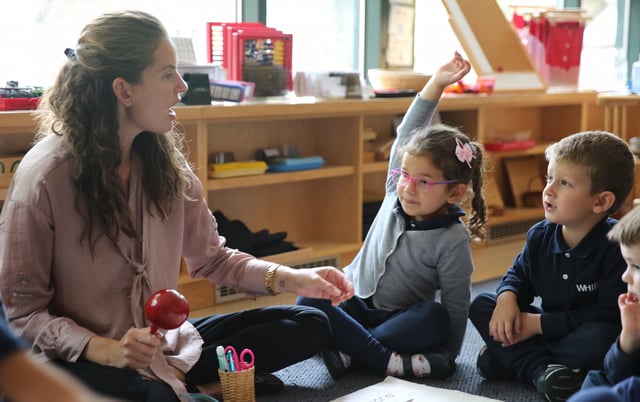Student centered learning is a teaching model where students are at the center of the educational process. Unlike the traditional education model where a teacher lectures from the front of the classroom, student centered learning is focused around inspiring students to direct their own learning.
The Focus of Student Centered Learning
Schools with student focused educations build their classrooms around activities and project work that allow the student a variety of self-directed choices and approaches. The idea is to link learning with real life situations and to rely on the student's inner motivation rather than a teacher/authority figure "pouring knowledge into an empty vessel."
As the first Nursery through Grade 8 school in the U.S. to be certified by the American Montessori Society (accredited with non-traditional Montessori age groupings) and the International Baccalaureate Organization, we frequently talk to parents interested in student centered learning.

Here are the 9 biggest myths parents have about student centered learning:
Myth 1: Student centered classrooms are out of control.
The Reality: While the students are busy talking, conferring and working together on projects, the classroom can be noisy and appear chaotic to parents used to lecture-based classrooms. This is a good thing. Recent research shows that forcing kids to sit quietly actually increases fatigue and lowers concentration and long-term memory.
Myth 2: Quiet students don’t flourish in an open classroom environment.
The Reality: In a student centered classroom, children have the opportunity to work in ways that they learn best. If you were to step into a Lower School classroom at Whitby, for example, you would likely see a small group of students working together in one part of the room, a couple students paired off in another corner, and a couple students working individually. Students get the opportunity to learn in the way they do best.
Myth 3. Student centered learning is only for the gifted.
The Reality: This myth is founded on the notion that only certain students have the ability to guide their own learning. However, much of what guides a student in their learning comes from what excites them. If you’ve ever seen a child light up when talking about a particular subject (like dinosaurs or the solar system) you know what this looks like. Every student is capable of throwing themselves into learning and the student centered approach is equally effective for all types of learners. The focus is on the student and the goal is success.
Myth 4: Student centered teaching is too permissive. Children need boundaries.
The Reality: The student centered approach is to give students freedom to direct their education, but within specific limits. Both Montessori and IB schools encourage independence, but the independence is tied to self-discipline and respect for others. Said independence comes as the child displays self-respect, respect for others and stays within those boundaries.
Myth 5. The unstructured classroom allows students to do whatever they want all day long.
The Reality: Yes, children in the student centered model do have more freedom, but they choose their work within a structure and schedule for their school day. The approach strives to give students the freedom to fully investigate a subject while still giving them the knowledge they need to succeed academically.
Myth 6: Students cannot learn new material on their own.
The Reality: They can and they do. How many video games have children learned on their own and won? No one had to teach them. Likewise, in a student centered learning environment, the resources and the materials are at hand. The student thrives, contributes and benefits as ideas and approaches percolate and the teacher becomes the "guide on the side."
Myth 7: Allowing children to work at their own pace can cause them to fall behind.
The Reality: Nothing could be further from the truth. Rebecca A. Marcon, a psychology professor at the University of North Florida, compared 343 children in lecture-focused classrooms and student centered classrooms. She found that by fourth grade, students who had more chances to learn through exploration earned significantly higher grades than those in more lecture-focused classrooms.
Myth 8. Student centered learning only works for well-behaved children.
The Reality: Many students act out because they’re bored and the classroom environment doesn’t match up with how they learn. Well-trained and reflective teachers can use student centered learning to create a classroom environment that engages active children and captures their interest. Once the engagement occurs, even the most boisterous child can focus and learn.
Myth 9: Student centered learning is only for preschool children.
The Reality: Many parents associate student centered learning with Montessori preschools, and assume those programs end after preschool. As the first Montessori school in the U.S., we’ve learned that students benefit from being encouraged to pursue their interests all the way through eighth grade. As students enter pre-adolescence, being encouraged to follow their passions can help them stay focused on learning.
The Path to Lifelong Learning
Student centered learning, particularly the Montessori approach, promotes a partnership between the learners, their peers, and the teacher as a facilitator. As students discover that learning is dependent on active engagement, their horizons widen with no ceilings on achievement.


